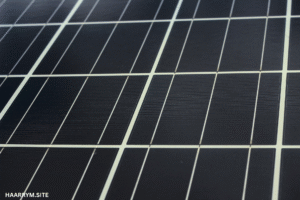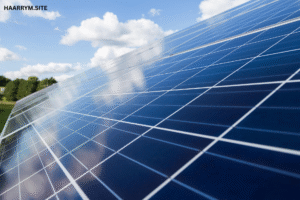Introduction
More homes and companies are switching to solar panel systems as solar power keeps rising in popularity as the mainstream renewable energy source. widely referred to as a grid-tied solar inverter, the inverter on grid solar systems is among the most widely used ones nowadays. By linking your solar panels directly to the public power grid, this technology maximises efficiency and reduces reliance on fossil fuels.
This article will go over on-grid solar inverter operation, benefits, and considerations to be taken before installation. Optimising energy output depends on knowing the fundamental of the inverter on grid solar systems regardless of your position—homeowner, company owner, or solar installer.
What Is an Inverter on Grid Solar System?
A vital part of a solar power system linked to the public electrical grid is an on-grid solar inverter, often referred to as a grid-tied inverter. Most home appliances run on alternating current (AC), which is produced from direct current (DC) power supplied by solar panels; this may be sent back to the grid.
An on-grid solar inverter transmits extra electricity straight to the grid, unlike off-grid systems which need batteries to store excess power. Local net metering rules will determine whether your power provider grants credits or money in return.
How Does an On-Grid Solar Inverter Work?
Here’s a step-by-step breakdown of the process:
-
Solar panels capture sunlight and convert it into DC electricity.
-
The inverter on grid solar system takes that DC power and converts it into AC power.
-
The electricity is then used to power your home or business.
-
Any excess electricity not immediately used is fed into the utility grid.
-
At night or during cloudy days, when your panels aren’t producing energy, you draw electricity from the grid.
Because it doesn’t require battery storage, this setup is cost-effective and low maintenance compared to hybrid or off-grid systems.
Why Choose an Inverter on Grid Solar System?
1. Cost-Efficiency
One of the biggest advantages of a grid-tied system is its affordability. By eliminating the need for batteries, you reduce installation and maintenance costs. Moreover, net metering allows you to earn credits for feeding electricity back into the grid.
2. High Efficiency
Grid-tied solar inverters are designed to operate at optimal efficiency. Most modern models come with Maximum Power Point Tracking (MPPT) technology, which ensures the inverter extracts the most power possible from your solar panels.
3. Easy Maintenance
Without a battery system, there are fewer components to maintain or replace. Inverters typically last 10–15 years and require minimal upkeep.
4. Eco-Friendly
By using solar energy and feeding excess energy back into the grid, you’re reducing your carbon footprint and promoting renewable energy adoption.
5. Scalability
Whether you start small or plan to expand, on-grid solar systems are highly scalable. You can add more panels or upgrade your inverter as needed.
Types of Grid-Tied Inverters
1. String Inverters
-
Description: Connects a string (series) of solar panels to a single inverter.
-
Best for: Systems with consistent sunlight exposure.
-
Pros: Lower cost, simpler design.
-
Cons: Reduced performance if one panel is shaded.
2. Microinverters
-
Description: Installed on each individual solar panel.
-
Best for: Roofs with shading issues or panels facing different directions.
-
Pros: Better performance and monitoring.
-
Cons: More expensive than string inverters.
3. Power Optimizers (with Central Inverter)
-
Description: Attached to each panel to optimize power before sending it to a central inverter.
-
Pros: Good balance between efficiency and cost.
-
Cons: Slightly more complex installation.
Each type of inverter on grid solar setup has unique advantages, so choosing the right one depends on your roof layout, budget, and energy goals.
Key Features to Look for in an On-Grid Inverter
When selecting a grid-tied inverter, consider these important features:
1. Efficiency Rating
Look for inverters with efficiency above 95%. This ensures more of your solar energy is converted into usable electricity.
2. MPPT Technology
This allows the inverter to dynamically adjust and extract the maximum power possible from your panels under varying conditions.
3. Monitoring Capabilities
Modern inverters come with Wi-Fi or app-based monitoring tools that let you track performance, detect faults, and optimize output.
4. Warranty and Support
A reliable inverter should come with a 10-year warranty or more. Also, consider the manufacturer’s customer support and local service availability.
5. Compliance and Safety Certifications
Ensure the inverter complies with local grid regulations and has certifications like UL 1741, IEEE 1547, or CE standards.
Installation Considerations for Grid-Tied Inverters
While the inverter on grid solar system is relatively straightforward, professional installation is crucial for safety and performance.
1. System Sizing
Work with a solar installer to determine your electricity needs and appropriately size your system and inverter.
2. Inverter Placement
Keep your inverter in a cool, shaded, and well-ventilated area to enhance its lifespan and reduce overheating.
3. Connection to the Grid
You’ll need approval from your local utility to connect to the grid. They may require specific inverters or shut-off capabilities for safety.
4. Permits and Inspections
Most regions require permits and electrical inspections before your system can be turned on. Your installer will typically handle this process.
Net Metering: Earning from Your Excess Power
One of the key financial advantages of an inverter on grid solar system is net metering. This billing mechanism allows solar users to:
-
Export unused solar power to the grid.
-
Receive credits on their electricity bill.
-
Offset the cost of energy consumed at night or during cloudy days.
Net metering policies vary by region, so check with your local utility or energy provider to understand how it applies in your area.
Common Brands of On-Grid Inverters
Here are some top brands known for their reliable grid-tied solar inverters:
1. SMA Solar Technology
-
German-engineered
-
Robust performance in harsh conditions
-
Excellent monitoring tools
2. SolarEdge
-
Uses optimizers with central inverter
-
Great for complex roof layouts
-
Highly efficient with smart monitoring
3. Enphase Energy
-
Specializes in microinverters
-
High performance for shaded areas
-
Modular and easy to expand
4. Fronius
-
Offers high-efficiency string inverters
-
Durable and scalable
-
Strong service support network
5. Growatt & GoodWe (China)
-
Budget-friendly
-
Ideal for residential installations
-
Increasingly recognized for reliability
When selecting your inverter on grid solar, factor in budget, system size, roof conditions, and after-sales service.
Inverter on Grid Solar vs. Off-Grid Systems
| Feature | On-Grid System | Off-Grid System |
|---|---|---|
| Power Backup | No (uses grid) | Yes (uses batteries) |
| Cost | Lower (no batteries) | Higher (battery cost) |
| Efficiency | High | Moderate (due to storage loss) |
| Maintenance | Low | High |
| Net Metering | Yes | No |
While off-grid systems offer independence, they are more expensive and complex. On-grid systems, powered by an efficient solar inverter, strike the perfect balance between cost and performance for most users.
Future Trends in Grid-Tied Inverters
As technology evolves, inverter on grid solar systems are becoming more advanced and user-friendly. Some key trends include:
-
AI and smart grid integration for predictive maintenance
-
Hybrid inverters allowing optional battery backup
-
Blockchain-based energy trading using solar credits
-
Faster and more granular monitoring systems
Adopting these technologies can make your solar system more resilient, efficient, and aligned with future energy infrastructure.

Conclusion
On grid solar systems, an inverter is a clever, environmentally beneficial, reasonably priced method of producing pure power. Maximising energy output and returns on investment depends on selecting the correct grid-tied inverter whether solar panels are installed for a house or a business site.
These systems, with little maintenance, net metering incentives, and great efficiency, mark the direction of easily available renewable energy. From choosing the right kind to knowing how it operates, every element helps a solar system run as it should.
Purchasing a grid-tied solar inverter now not only saves money over time but also advances a sustainable future for everybody.
SEO Tips: Additional Keywords to Target
To improve search engine visibility, consider naturally incorporating these LSI (Latent Semantic Indexing) keywords:
-
grid-connected inverter
-
solar power inverter
-
AC solar inverter
-
solar energy conversion
-
grid-tied photovoltaic system
-
net metering solar
-
smart solar inverter
